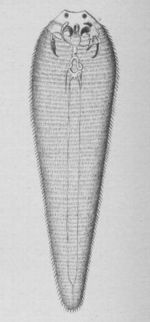Linguatula serrata
Jump to navigation
Jump to search
- Also known as the tongue worm
- A highly specialised arthropod
Recognition
- Tongue-like appearance
- Expanded anteriorly
- Adults are over 10cm in length
- Females measure between 30-130mm in length
- Males measure up to 20mm in length
- Transversely striated
Life cycle
- Life cycle takes 6 months
- Adults inhabit the nasal passages of dogs and sometimes cats
- Eggs are expelled by coughing and sneezing or are passed out with the faeces
- Herbivorous intermediate hosts ingest the eggs
- Eggs hatch in the herbivore intestine
- Larvae migrate to the mesenteric lymph nodes and encyst to become infective nymphs
- Cysts measure 1mm in diameter
- When a dog eats infected uncooked viscera the life cycle is completed
- Infective nymphs migrate from the viscera during chewing and crawl up into the nasal cavity via the soft palate
- Infective nymphs mature to adults in the nasal cavities and can survive for a year in the final host
Pathogenesis
- Causes rhinitis
- Heavy infection leads to coughing, sneezing and nasal discharge
- Synonym: tongue worm
- In nasal passages of dogs, sometimes cats
- May reach the sinuses
- Heavy infections may cause sneezing, coughing, nasal discharge
